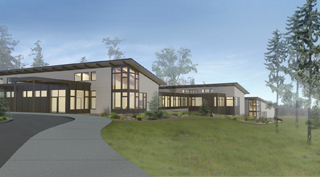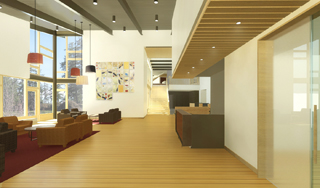|
Subscribe / Renew |
|
|
Contact Us |
|
| ► Subscribe to our Free Weekly Newsletter | |
| home | Welcome, sign in or click here to subscribe. | login |
Construction
| |
 |
June 23, 2011
Friday Harbor hospital aims to be nation’s greenest
Mahlum Architects

Goodfriend
|
A 10-bed critical access center and primary care facility to be built on San Juan Island beginning this summer will set benchmarks for new sustainable hospitals nationwide.
The 38,000-square-foot PeaceHealth Peace Island Medical Center embraces the Living Building Challenge as a framework and reflects PeaceHealth’s commitment to integrated sustainable design, which has been difficult to achieve in traditional hospitals and health care facilities.
Given the remote location, limited resources and the community’s commitment to sound environmental practices, our design team felt it was appropriate to propose an aggressive sustainability stance. We viewed it as an opportunity to reevaluate building-system design strategies and streamline clinical work flows within the context of limited island resources and appropriate regional design.
Moreover, the Living Building Challenge framework fully aligns with the mission of PeaceHealth, a Catholic not-for-profit health care system with hospitals in Alaska, Oregon and Washington, that champions environmental stewardship as one of its core values.
A light touch
Completion of the facility is scheduled for late 2012. In addition to the 10 beds, the facility will include emergency, imaging and surgery departments as well as an ambulatory and specialty care center.
Out of respect for the natural beauty of the island, the design touches the site lightly and preserves its natural beauty. Development will be limited to the previously disturbed and least forested portion of the 22-acre site, preserving the balance for the community to enjoy.
The facility footprint will cascade down the site’s slope in three narrow building forms connected by two intervening links. By following the topography of the land, excavation of bedrock will be minimized, existing stormwater patterns will be preserved and entries will be consistent with the natural grade of the property. The orientation of the buildings will maximize the use of passive solar heating, natural ventilation and daylighting.
The main entry will be on the lower level on the south side of the site, with the emergency department entry on the north. Visitors will be able to move from the lower level to the upper through a naturally lit, double-height space via elevator or grand staircase, continuing on through the open-circulation spine that tracks from the main lobby to the emergency entry.
Although the medical center will have space for 10 patient beds, rooms have been designed for multiple uses. This flexibility will allow five beds to function as pre/post surgery recovery beds, with the balance serving as overflow for the emergency department and as observation beds.
Wood milled from trees harvested on the site will be used for many details, both inside and outside the building. When possible, building materials will be locally sourced. An arts committee has been created by PeaceHealth to identify Northwest artists who will supply art for the building.
The medical center will be linked to the town by extensions of the island’s trail system, giving islanders a place to walk and exercise within the natural habitat that will be preserved on the property. There will also be healing gardens adjacent to the main circulation spine and off the public waiting areas, and a new bus stop will be added to encourage people to take public transport.
Pursuing carbon neutrality
The design and selection of the heating and ventilation systems was driven by the specific program requirements of the area served, as well as the department hours of operation and state Department of Health requirements. All patient rooms will have the option to be naturally ventilated with operable windows.
Excess heat from diagnostic and imaging equipment will be recovered and transferred to areas with a heating need. A ground-source heat pump system will provide the primary source of heating and cooling for most of the year, dramatically increasing the hospital’s energy efficiency.
Because only 7 percent of the source energy used by the medical center comes from fossil fuel sources, the design team is studying the purchase of green power to achieve total carbon neutrality.
A low-impact approach to site development will be taken. Stormwater will be managed to mimic pre-development conditions of the site, making use of two existing untouched wetlands that will be restored as part of the project. Runoff from the 90-stall parking lot will be treated in adjacent rain gardens. Grading and site impact will be minimal.
The medical center will use much less energy than a typical Northwest hospital, with the goal of it becoming the most energy-efficient hospital in the country. Current plans target an Energy Use Index of less than 100 kilo-British thermal units per square foot a year, compared with a typical Northwest hospital usage of 270.
Flower power
The Living Building Challenge is a philosophy and certification program that supports the most advanced sustainability in seven areas or “petals”: site, water, energy, health, materials, equity and beauty. Achieving the Challenge was particularly difficult due to the high cost of construction materials free of toxic chemicals on what is known as the “red list.” Additionally, there were challenges obtaining approval from the local municipalities for water reclamation, reuse and on-site treatment.
Launched in 2006, the Challenge brings together the most progressive thinking from architecture, engineering, planning, landscape design and policy. It is based on ideals rather than achieving a better percentage compared with current building codes.
The Challenge uses the metaphor of a flower, which gets its nutrients while improving its surroundings and causing minimal environmental impact. This framework provided us a tangible way to move forward and seek a common commitment to innovative solutions in as many of the “petals” as possible.
The Challenge poses the question, What if every single act of design and construction made the world a better place?
Erik Goodfriend is the lead medical planning principal for the Peace Island project. He has been with Mahlum for 12 years.
Other Stories:
- 13 tips for choosing your medical space
- Study will help UW’s Montlake Tower cut energy costs
- Swedish Issaquah aligns design with patient needs
- Good signage points the way to better health care
- 'Novel' process lets Swedish Issaquah hit fast forward
- ‘Hybrid’ rooms a low-cost answer to space needs
- Swedish women’s cancer center a one-stop shop
- Group Health is designing its clinic of the future
- Puyallup hospital tower puts focus on patients
- Evergreen opens center closer to its patients
- New VA complex to treat ‘emerging’ war injuries
- UW expansion stays on track despite big change in plans




